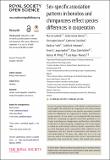Files in this item
Sex-specific association patterns in bonobos and chimpanzees reflect species differences in cooperation
Item metadata
| dc.contributor.author | Surbeck, Martin | |
| dc.contributor.author | Girard-Buttoz, Cédric | |
| dc.contributor.author | Boesch, Christophe | |
| dc.contributor.author | Crockford, Catherine | |
| dc.contributor.author | Fruth, Barbara | |
| dc.contributor.author | Hohmann, Gottfried | |
| dc.contributor.author | Langergraber, Kevin E. | |
| dc.contributor.author | Zuberbühler, Klaus | |
| dc.contributor.author | Wittig, Roman M. | |
| dc.contributor.author | Mundry, Roger | |
| dc.date.accessioned | 2019-11-21T17:30:07Z | |
| dc.date.available | 2019-11-21T17:30:07Z | |
| dc.date.issued | 2017-05-03 | |
| dc.identifier | 263484765 | |
| dc.identifier | c6a55dc6-1fba-4efe-aad1-91300fef8571 | |
| dc.identifier | 85018459298 | |
| dc.identifier.citation | Surbeck , M , Girard-Buttoz , C , Boesch , C , Crockford , C , Fruth , B , Hohmann , G , Langergraber , K E , Zuberbühler , K , Wittig , R M & Mundry , R 2017 , ' Sex-specific association patterns in bonobos and chimpanzees reflect species differences in cooperation ' , Royal Society Open Science , vol. 4 , no. 5 , 161081 . https://doi.org/10.1098/rsos.161081 | en |
| dc.identifier.issn | 2054-5703 | |
| dc.identifier.other | ORCID: /0000-0001-8378-088X/work/65013922 | |
| dc.identifier.uri | https://hdl.handle.net/10023/18980 | |
| dc.description | M.S. thanks the Leaky Foundation, the Wenner Gren Foundation, the National Geographic Society, Basler Stiftung fuer Biologische Forschung and the SNF. B.F. and G.H. thank the DFG, DAAD, National Geographic Society, Leakey Foundation, Volkswagen Foundation and Ludwig Maximilians Universitaet Muenchen for funding this research. K.E.L. thanks the Leakey Foundation for funding. K.Z. acknowledges the Royal Zoological Society of Scotland for providing core funding to the Budongo Conservation Field Station, and the European Research Council (grant PRILANG 283871) for providing core funding for the research. M.S., C.B., C.G.-B., C.C., R.M.W. and G.H. thank the Max Planck Society for funding. | en |
| dc.description.abstract | In several group-living species, individuals’ social preferences are thought to be influenced by cooperation. For some societies with fission-fusion dynamics, sex-specific association patterns reflect sex differences in cooperation in within- and betweengroup contexts. In our study, we investigated this hypothesis further by comparing sex-specific association patterns in two closely related species, chimpanzees and bonobos, which differ in the level of between-group competition and in the degree to which sex and kinship influence dyadic cooperation. Here, we used long-term party composition data collected on five chimpanzee and two bonobo communities and assessed, for each individual of 10 years and older, the sex of its top associate and of all conspecifics with whom it associated more frequently than expected by chance. We found clear speciesdifferences in association patterns. While in all chimpanzee communities males and females associated more with same-sex partners, in bonobos males and females tended to associate preferentially with females, but the female association preference for other females is lower than in chimpanzees. Our results also show that, for bonobos (but not for chimpanzees), association patterns were predominantly driven by mother-offspring relationships. These species differences in association patterns reflect the high levels of male-male cooperation in chimpanzees and of mother- son cooperation in bonobos. Finally, female chimpanzees showed intense association with a few other females, and male chimpanzees showed more uniform association across males. In bonobos, the most differentiated associations were from males towards females. Chimpanzee male association patterns mirror fundamental human male social traits and, as in humans, may have evolved as a response to strong between-group competition. The lack of such a pattern in a closely related species with a lower degree of between-group competition further supports this notion. | |
| dc.format.extent | 20 | |
| dc.format.extent | 746530 | |
| dc.language.iso | eng | |
| dc.relation.ispartof | Royal Society Open Science | en |
| dc.subject | Competition | en |
| dc.subject | Kinship | en |
| dc.subject | Pan paniscus | en |
| dc.subject | Pan troglodytes | en |
| dc.subject | Sexual segregation | en |
| dc.subject | Sociality | en |
| dc.subject | BF Psychology | en |
| dc.subject | DAS | en |
| dc.subject.lcc | BF | en |
| dc.title | Sex-specific association patterns in bonobos and chimpanzees reflect species differences in cooperation | en |
| dc.type | Journal article | en |
| dc.contributor.institution | University of St Andrews. School of Psychology and Neuroscience | en |
| dc.contributor.institution | University of St Andrews. Institute of Behavioural and Neural Sciences | en |
| dc.contributor.institution | University of St Andrews. Centre for Social Learning & Cognitive Evolution | en |
| dc.identifier.doi | 10.1098/rsos.161081 | |
| dc.description.status | Peer reviewed | en |
This item appears in the following Collection(s)
Items in the St Andrews Research Repository are protected by copyright, with all rights reserved, unless otherwise indicated.

